
views
X
Trustworthy Source
Mental Health Foundation
UK charity working towards good mental health for all.
Go to source
Striking a good balance can be as simple as setting clear boundaries and priorities—but there are plenty of other ways to draw a professional line in the sand, too. Read on to learn plenty of easy and applicable ways to add a healthy sense of structure and harmony to your daily life.
Best Ways to Promote Work-Life Balance

Say "no" to projects that you don't have time for. It may seem rude or selfish at first, but, with practice, you may find that selectively turning down different projects or opportunities is quite freeing. Say "yes" to those requests that meet your top priorities and that do not constrain your already packed schedule. Here's how to say "no": “No, thanks. That’s not a good fit for my schedule right now.” “Thanks so much for thinking of me, but I’m not available right now.” “My calendar is really full for the next few weeks, but I might be free to help next month.”

Cut back on work if you’re spread too thin. Let your employer know what you can and can’t handle. If asked to do something or assigned a task that isn’t manageable, say something like: “With my current project load, I won’t have enough time to get this done by the end of the day.” “Is there someone else who could tackle this? I already have a lot on my plate right now.” “I can finish my current assignment or complete this new one, but I can’t do them both. Which would you prefer I work on?”

Make a list of priorities. Create a list of different categories, like your job, romantic relationships, loved ones, and so on. Review your list and rank these items starting with #1 as the most important, #2 as the second most important and so on. Your rankings will show where your priorities lie, and it’ll be easier to incorporate these top priorities into your daily and weekly schedules.
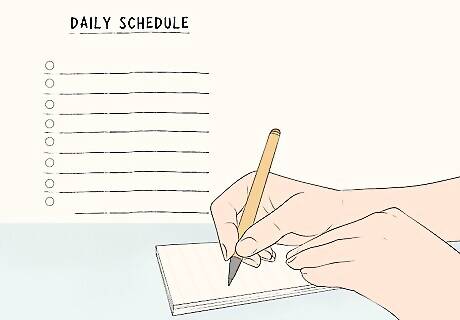
Create a daily schedule. It can be most helpful to develop a weekly schedule involving all the constants like work, classes, church, and social activities with other one-time events. Each night, map out a daily to-do list of the individual tasks you need to get done based on your priorities. When making your daily schedule, highlight the three most important tasks you need to get done each day (aside from actually going to work or going to school). These might be professional items like working on a presentation or personal items like going to the dentist or your daughter's ballet recital. Keep in mind that your priorities may change over time, and that’s okay!
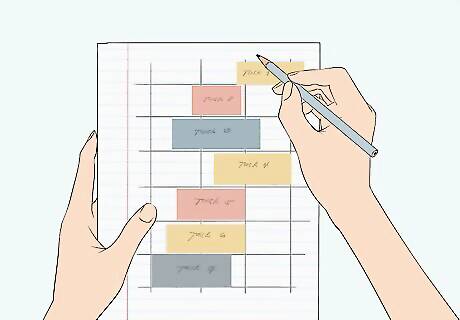
Block your time for specific tasks throughout the day. Before you start your workday, identify what you’ll be working on throughout the day, and for how long. Dedicate the most time and energy to high-priority tasks, while identifying which parts of your schedule aren’t as important or time-sensitive. By setting clear boundaries in your schedule, it’s easier to unplug and step away at the end of the workday. For instance, you might block off your whole morning to an important project, and then block off smaller chunks of time for less time-sensitive tasks in the afternoon.
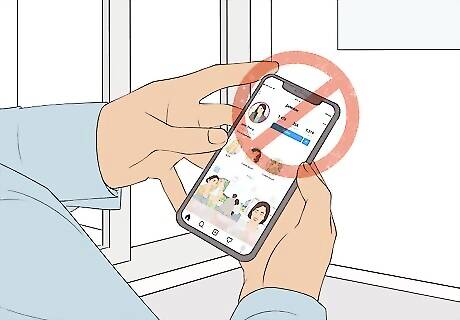
Get rid of workplace distractions. If you can minimize the distractions in your professional life, you can prevent them from constantly interfering with your personal life. Try these tips to stay productive and on-task at work: Give yourself permission to respond to messages at a later time. Put your personal devices on silent or “do not disturb.” Put your phone on airplane mode when you really need to focus. Direct emails to the necessary individuals rather than sending “reply all,” which can lead to muddled, confusing, and distracting email threads.

Take meaningful breaks throughout the work day. Working nonstop isn’t good for anybody’s well-being, and can contribute to a poor work-life balance in the long run. Whenever you take a break, set aside intentional time to really detach from whatever it is you’re working on. You might: Text a friend for a few minutes Make yourself a cup of coffee Take a short walk outside Imagine a fun vacation you’d like to take

Create separate social media profiles for work. With social media becoming an ingrained part of most people's work and home lives, it can be hard to separate the two. If you are active online in both your professional and personal lives, it's important to create a distinction between them to monitor what is being put out in the online world regarding that side of you. Many people choose to use LinkedIn for their career or academic connections and Facebook or Instagram for friends and family.

Give yourself specific windows of time to check social media. If social media is a part of your professional life, you may find yourself spending excess time online beyond what's necessary for your job. Logging on several times a day or whenever a notification pops up is disruptive to both your professional and personal life. It can also help to delete certain apps from your phone, or to at least switch off notifications.
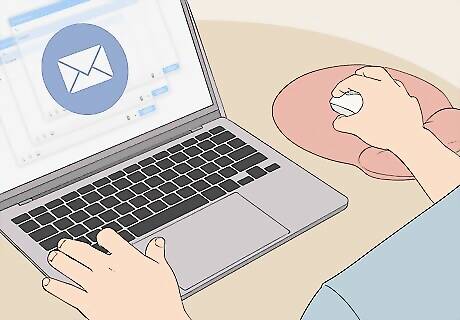
Check emails only when you’re at work. Staying on top of your inbox can be a daunting task, but it should only be a task when you’re on the clock. Once you punch out for the day, turn off notifications for your work’s email app, or simply refuse to acknowledge the new emails until you’re working again. It can be hard to separate your work and professional life when you’re checking work emails on your personal time. The same logic applies to phone calls—if you receive a work-related call during your off-hours, simply call back during your working hours.

Make time for hobbies when you’re off the clock. Your off-time is meant for you to rest and recharge, so why not spend it doing activities that you find rejuvenating? Dedicate your time and energy to hobbies that you find fulfilling, whether that’s: Playing sports with your friends Playing video games Doing a craft Cooking a delicious meal

Take your vacation time. Vacation is there to give you a paid opportunity to unplug from your usual work schedule. Taking intentional time to rest and relax is a great way to help you detach from your work while spending time with the people you care about (all while catching up on some zzzs). If you don’t have a vacation planned in the next few months, think about penciling one into your schedule. Try to plan a small trip, even if your employer doesn’t offer vacation time. It’s important to have time and space for yourself!

Chat with your employer if you’re feeling burned out. Explain what would help you feel a little less overloaded, and what would help you to feel a little less stressed in your day-to-day routine. If your employer isn’t responsive, step away and take some time to collect your thoughts before trying again. See if your workplace offers an Employee Assistance Program (EAP). This type of program can help iron out difficulties you might run into as a working adult, like finding a local therapist.
Work-Life Balance Tips for Remote Workers

Create a distinctive work zone for remote work. If you have to work inside your home, do your best to create a separate space for yourself, like a special desk or a specific portion of your couch. If you telecommute or go to school online, you might find it helpful to get work done at a local library, coffee shop, or cohab community for students or telecommuters. When your work is done, you can physically leave the environment, which might help you to transition to your personal life.

Follow a set routine each day. Create a stable, maintainable schedule as you work from home: go to bed at a consistent time, wake up at a consistent time, eat meals at a consistent time, and so on. The more distinct your routine is, the easier it is to separate your work time from your personal time.

Maintain set work hours. It can be hard to maintain the same work hours every day when you work from home, but maintaining regular work hours can help you to keep your work and home life separate. Choose realistic work hours and stick to them. For example, you might decide to work from 8:00am to 4:30pm on Monday through Friday. Don’t let your work hours creep into your personal time. When it is time to stop for the day, stop working, shut down your laptop, and step away from your workspace. Try to set work hours that work with your personal life. For example, try to avoid working on the weekends if you know that there are things you will want to do. Tip: Give yourself the freedom and wiggle room to adjust your hours to accommodate your family. For instance, if you have kids, it might make more sense to get some work done in the morning before getting them ready for school.

Dress for work even when you are at home. Change into work clothes in the morning and non-work clothes in the evening. Rolling out of bed and going straight to your workspace in your pajamas will make it harder for you to transition into your workday. The same thing goes for wearing your work clothes into the evening. Try getting up about 30 to 60 minutes before you want to start working for the day so that you can get dressed for work. Make sure that you change out of your work clothes when it is time to relax. For example, you can switch to pajamas or your favorite jeans and a t-shirt.

Take a lunch break. When you work at an office, taking a lunch break is necessary and you may even have someone else reminding you to take one. However, when you work from home, it can be hard to remember to take lunch breaks and you may be tempted to work through your lunch or eat at your workspace. Setting aside intentional time for lunch can help your home feel more like a workplace. Set a time for your lunch break to start and end every day. For example, you might agree to take lunch from 12:00 to 12:30 each day. Ask a family member or significant other to remind you when it is time for your lunch break. If you are worried about forgetting to take a lunch break, then ask one of your friends or family members to come get you when it is time for a break.
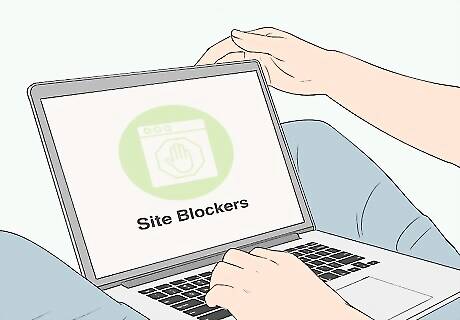
Use site blockers to create a barrier between your work tasks and free time. Tools like Cold Turkey, BlockSite, LeechBlock NG, and Freedom are all great tools for blacklisting sites for certain periods. If you use the same device for both work and play, set restrictions that prevent you from accessing work items on your off-time (or distracting websites during your workday).
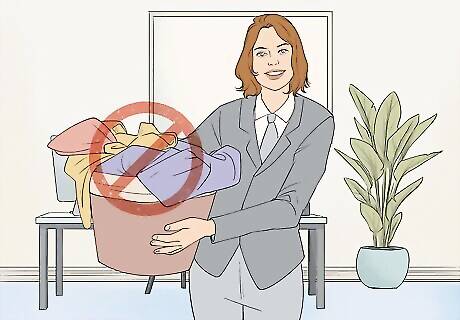
Avoid doing household tasks during work hours. You may be tempted to do things around your house while you are taking a quick break or making a work phone call, but this can blur the dividing line between work and home. Try to prevent yourself from doing any housework or anything that is not work-related while you are on the clock. If you notice a household chore that you want to complete, write it down on a notepad and save it for the end of your work day. Keep in mind that everyone is different. For example, if you find that folding laundry is a soothing way for you to spend a break, then go for it!

Treat yourself at the end of the day. Finding a simple way to reward yourself for a hard work day is also important. You can reward yourself with a walk outside, a cup of tea, a chat with a friend, or any other pleasant activity that indicates your work day is over. Consider doing something social at the end of each day. Working from home can be isolating, so you need to find ways to interact with other people. You can do this by talking to your significant other, meeting up with some friends for coffee, or taking an aerobics class after work.

Take advantage of childcare options if you have children at home. Asking someone to watch your kids for a few hours each day can also be a great way to get things done. If you have willing grandparents or other family members close by who are willing to watch your children for a few hours every day, then you may want to take advantage of that. Consider what works best for you and your babysitter. For example, maybe your parents can come over to the house, or you can drop your kids off for a playdate with grandma a few times a week. A trustworthy babysitter can also be a great option if you can afford to pay someone to watch your kids. If you do not have a good regular babysitter, ask friends and family if they know anyone.

Utilize busy boxes if you have kids at home during your work hours. If you don’t have anyone to watch your kids while you work during the day, then you will often need to find other ways to keep them busy with something while you work. One way to do this is to create a busy box with lots of fun items to keep your child busy while you work. A busy box is filled with a variety of toys and activities that are meant to keep your child entertained while you work. For example, a busy box might include, crayons, clay, a coloring book, stickers, puzzles, and other toys for your child. Prepare busy boxes the night before and place them near your workspace. You can use an empty shoe box or other small box and select from your child’s toys and other items to create the box. You might even throw in a surprise now and then, such as a new coloring book or a new package of stickers. You can even create themes for busy boxes. For example, if you want to teach your child about colors, you can make boxes with collections of red items, blue items, etc. Or, you might create a theme for a busy box based on one of your child’s favorite movies, books, shows, or characters.
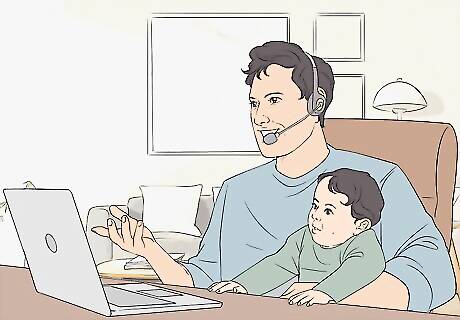
Work in the same room with your kids if you have young children at home. It is a good idea to work in the same room with your kids so that you can supervise them and provide them with more entertainment options as needed. For example, if you work out of your home office, you might create an area for your kids by placing a special rug or play mat along with some of your child’s favorite toys. You might also need to learn how to talk to your kids and play with them while you work. Being able to work and engage with your kids at the same time is a skill, but you can develop this skill with practice. If you have a backyard with a play area for your kids or a nearby park with a playground, then you might even consider taking your work outside for an afternoon.


















Comments
0 comment